Research on the Load Distribution Strategy to Meet the QoE Requirements for Conversational Real-Time HD Video Service
Abstract
1. Introduction
- (1)
- Without changing the existing network structure, we used P2P and SDN (software defined network) technology for reference [2,3]. Through the deployment of a relay controller and relay server in the backbone network, we used a software defined overlay network to solve the end-to-end transmission bottleneck problem and provided a relay service to meet the needs of users’ QoE for conversational real-time HD video service;
- (2)
- According to the types of network service defined by 3GPP (3rd Generation Partnership Project), we analyzed the impact of key QoS indicators on the transmission quality of conversational service. Then, we used the subjective evaluation method of service quality provided by ITU-T (ITU Telecommunication Standardization Sector) for reference [4] and built the mapping relationship between the service QoE and QoS indicators based on expert experience and the user’s subjective perception;
- (3)
- Considering the coupling relationship among the sub-paths in the process of multipath relay transmission, we used the theory of fuzzy cooperative games to design the service load distribution strategy. The strategy combines real-time feedback information of each sub-path and uses the reward function to dynamically adjust the load distribution, while the reliable transmission meeting the QoE requirements of service can be obtained under ensuring the service delay.
2. Related Works
3. The Multipath Relay Transmission Scenario
3.1. The Software Defined Overlay Network
- UA (User Agent): It is mainly responsible for the interaction of end users and provides users with an interface to the overlay network architecture. The work content of the UA includes two aspects: One is the processing of control process, mainly including the transmission request of end users, the path information interaction of multipath transmission. The other is the transmission of media data, mainly including the load distribution and sub-stream reorganization;
- RS (Relay Server): It is mainly responsible for the aggregation and forwarding of media data among UAs. According to the idea of SDN, all behaviors of RS are under the centralized control of an RC. The work content of an RS mainly includes two aspects: One is the processing of control process which is mainly the interaction of relay transmission path information with the RC. The other is the transmission of media data which is mainly the multipath relay transmission of media data;
- RC (Relay Controller): It is mainly responsible for the management and control of all network element components in the overlay network from the whole network. The work content of the RC is divided into two stages: generating the global multipath transmission resource view in the initial stage and completing the scheduling and allocation of transmission resources; and processing the transmission request of a UA in the multipath transmission stage, performing the multipath relay transmission of media data, monitoring the quality of multipath transmission, and dynamically adjusting the transmission strategy according to the transmission feedback.
3.2. The Application Layer Multipath Relay Service
4. The Service QoE Evaluation
4.1. The Mapping Relationship between Service QoE and QoS
- Delay: Based on the diversity of network communication structure and underlying transmission protocol, the delay of conversational service is composed of fixed delay and variable delay. The fixed delay mainly includes coding and packing delay; it depends on the performance of terminal equipment, the compression algorithm, and the service data volume. The variable delay mainly includes the bearer network transmission, node queuing, service processing, and jitter removal delay; it depends on the port rate of the device, the load capacity of the network, the status of the transmission link, and the QoE mechanism. When there is random congestion in the network, the high delay will have a serious impact on the picture quality and fluency of the service; we took the delay of transmission path as a key index of the service quality evaluation without considering the terminal performance and codec mechanism;
- Jitter: The jitter index is closely related to the delay index. For packet transmission, the time-varying path state may cause the packet to arrive at the receiver cache inconsistent of time. When the receiver removes the impact of jitter on the quality of service, it may cause the network random congestion due to the packet loss retransmission. Therefore, we took the jitter as an important index of the service quality evaluation;
- Packet loss: During conversational service transmission, the main cause of packet loss is the random network congestion caused by insufficient service bandwidth. When there is random congestion in the network, the increase of queuing delay will increase the probability of packet loss due to the limitation of the buffer capacity which may lead to a short pause or mosaic for the service. Because packet loss is inevitable in the bearer network, we took the packet loss as a restrictive index of service quality evaluation under the premise of not exceeding the user tolerance.
- As shown in Figure 4a, for the user subjective perception, a delay 150 ms can obtain a good quality of service experience, and the smaller the delay, the better the subjective feeling of users. However, when a delay is 80 ms, the users can hardly perceive the impact of the delay on service quality. Even if the delay is further reduced, the users’ subjective feelings did not change significantly;
- As shown in Figure 4b, when the jitter 60 ms, it was easy to cause a large delay in the process of eliminating jitter which will cause a delay to exceed the upper limit that users will tolerate. When the jitter was 40 ms, the service quality was able to meet the needs of users combined with the close relationship between delay and jitter;
- As shown in Figure 4c, when the packet loss 6%, the poor service quality was intolerable to users. When 3% packet loss 6%, although there were some slight voice pauses or unclear video images during the conversation, the users could still get a satisfactory quality experience. Especially when packet loss 3%, the impact of packet loss on the service quality can be ignored.
4.2. The Service Load Distribution Strategy
- (1)
- When the transmission strategy chosen by each sub-path is not the best one, it will cause the loss of service quality. We used to express the responsibility of each sub-path for the loss of service quality so as to obtain the relationship between the optimal overall objective function and each sub-path’s objective function:As shown in Formula (2), is the objective function of each sub-path; is the actual transmission strategy adopted by each sub-path; is the maximum value obtained by the overall objective function , when each sub-path executes the optimal strategy ; is the maximum value of the objective function of each sub-path, when the maximum value is satisfied. If , because each sub-path does not adopt the optimal strategy, the overall objective function obtained will be lower than the optimal value with a great probability:
- (2)
- When the initial load distribution strategy adopted by each sub-path is not the optimal strategy, we used to adjust the load distribution of each sub-path, so as to ensure that the overall transmission quality of the service still satisfied . Formula (2) can be changed as follows:
- (3)
- From the above analysis, when , we can get . According to this conclusion, we set-up a set of reward functions and obtained a new objective function by the superposition of the initial function of each-sub path:As shown in Formula (5), we adjusted the initial objective function of each-sub path through the reward function , so that we can make the actual strategy of each-sub path closer to the theoretical optimal strategy according to the QoS conditions of the path in real time, and then ensured that the overall transmission quality of the service satisfied .
5. Experiment
5.1. The Simulation Environment
- Path 1 (The default path): Sender-> router1-> router4-> router3-> receiver;
- Path 2: Sender-> router1-> router2-> router3-> receiver;
- Path 3: Sender-> router1-> router5-> router3-> receiver.
5.2. The Sample Test
- When the service session starts, through real-time monitoring of the path information, we used as a constraint under the condition of judging the three sub-paths’ delay of 150 ms and, according to Formulas (8)–(10), to obtain instant load distribution strategy;
- When monitoring the path1 of 150 ms in 75 s, where its jitter changes significantly and the packet loss shows an increasing trend, we determined that path1 may have network congestion based on the mapping relationship between service QoE and QoS. In this case, since the data packets sent in sequence in multipath transmission will be used the ACK returned by the slow path as an acknowledgment response, in order to ensure the strict real-time constraints of the service, we set the load distribution ratio of path1 as 0 based on the limiting condition designed in the reward function. Then, we enabled the bypass retransmission mechanism and used Formula (9) and (10) to adjust the transmission strategy of other sub-paths with a delay 150 ms according to the constraint designed in the reward function.
6. Discussion
- (1)
- Providing an application layer relay service for conversational real-time HD video service involves many problems such as network resource scheduling, relay path generation, and relay path maintenance. The solutions to these problems have been detailed in our team’s other published papers [25,26]. Therefore, in the research work of this paper, we used path generation and measurement information as known input conditions to adjust the real-time transmission load distribution strategy. At the same time, considering the performance differences of relay nodes, we evaluated the transmission quality of a single relay path as a whole;
- (2)
- According to the concept of QoE, the QoE evaluation of service is the description of users’ perception of service quality. Because of the uncontrollability of users’ subjective perception, the current mainstream QoE evaluation methods of video streaming media service mainly adopt the way of big data processing. In order to achieve the goal of service QoE quantification, we established the mapping relationship between service QoE and QoS based on expert experience and users’ subjective perceptions after analyzing the QoE characteristics of conversational service. However, due to the limitation of experimental conditions, there may be some errors between our quantitative results and reality;
- (3)
- When using multipath relay transmission technology to carry out the load distribution of service data, the packet disorder caused by the difference between paths is inevitable, which may result in the performance of multipath transmission lower than that of single-path transmission. From the simulation test results, we can see that the QoS index of single-path transmission is not different from that of multipath transmission when the cache condition is not considered and the network is idle, while the ability of multipath transmission to deal with the random network congestion is more obvious when the network is busy. Therefore, in order to determine which network state should use the multipath relay transmission for service load distribution, we need to set the critical condition that the multipath transmission is better than the single-path transmission by comparing the service transmission rate;
- (4)
- The control plane is the core of the software defined overlay network management. When the control plane needs to expand the scale of the network, the control plane control load will change accordingly, then the control plane may also become a performance bottleneck and affect the quality of service transmission. Since scalability and time complexity are important factors to measure the performance of a method, the performance of the method we design mainly depends on the network scale of the control plane. Limited by the test conditions, the performance of the method may be affected in the application of actual complex networks.
7. Conclusions
Author Contributions
Funding
Conflicts of Interest
References
- ITU-T. TD 109rev2 (PLEN/12). Definition of Quality of Experience (QoE). 2007. Available online: https://www.itu.int/rec/T-REC-P.10-200701-S (accessed on 18 March 2020).
- Zhao, Y.X.; Liu, Y.; Chen, C.J.; Zhang, J.Y. Enabling P2P One-View Multiparty Video Conferencing. IEEE Trans. Parallel Distrib. Syst. 2013, 25, 73–82. [Google Scholar] [CrossRef]
- Aslan, M.; Matrawy, A. On the Impact of Network State Collection on the Performance of SDN Applications. IEEE Commun. Lett. 2015, 20, 5–8. [Google Scholar] [CrossRef]
- ITU-T. TP 800. Geneva Methods for Subjective Determination of Transmission Quality. 1996. Available online: https://www.itu.int/rec/T-REC-P.800 (accessed on 17 March 2020).
- Omneya, I.; Filippo, S.; Li, W. Estimation of Time Varying QoE for High Definition IPTV Distribution. In Proceedings of the Consumer Communications and Networking Conference (CCNC), IEEE, Las Vegas, NV, USA, 14–17 January 2012; pp. 326–330. [Google Scholar]
- Jia, Y.; Fu, Z.; Shu, A. QOE Evaluation of Video Services Considering Users’ Behavior. In Proceedings of the International Conference on Multimedia and Expo Workshops (ICMEW), IEEE, Chengdu, China, 14–18 July 2014; pp. 1–6. [Google Scholar]
- Shen, Y.; Liu, Y.; Qiao, N.; Sang, L.; Yang, D. QoE-based Evaluation Model on Video Streaming Service Quality. In Proceedings of the Globecom Workshops, IEEE, Anaheim, CA, USA, 3–7 December 2012; pp. 1314–1318. [Google Scholar]
- Volk, M.; Sterle, J.; Sedlar, U. An Approach to Modeling and Control of QoE in Next Generation Networks [Next Generation Telco IT Architectures]. IEEE Commun. Mag. 2010, 48, 126–135. [Google Scholar] [CrossRef]
- Peter, F.; Sebastian, E.; Raimund, S.; Michael, M.; Kathrin, M. QoE in 10 Seconds: Are Short Video Clip Lengths Sufficient for Quality of Experience Assessment. In Proceedings of the 4th International Workshop on Quality of Multimedia Experience, IEEE, Yarra Valley, Australia, 5–7 July 2012; pp. 242–247. [Google Scholar]
- Barakovic, J.; Bajric, H.; Husic, A. QoS Design Issues and Traffic Engineering in Next Generation IP/MPLS Network. In Proceedings of the 9th International Conference on Telecommunications, IEEE, Zagreb, Croatia, 13–15 June 2007; pp. 203–210. [Google Scholar]
- ITU-R. BT 500. Methodology for the Subjective Assessment of the Quality of Television Pictures. 2012. Available online: https://www.itu.int/rec/R-REC-BT.500-7 (accessed on 19 March 2020).
- ITU-R. BT 2021-2015. Subjective Methods for the Assessment of Stereoscopic 3DTV Systems. 2012. Available online: https://www.itu.int/rec/R-REC-BT.2021-2015 (accessed on 19 March 2020).
- Richardson, I.E.G.; Kannangara, C.S. Fast Subjective Video Quality Measurement with User Feedback. IEEE Electron. Lett. 2004, 40, 799–801. [Google Scholar] [CrossRef]
- Moss, F.M.; Wang, K.; Zhang, F.; Baddeley, R.; Bull, D.R. On the Optimal Presentation Duration for Subjective Video Quality Assessment. IEEE Tran. Circuits Syst. Video Technol. 2016, 26, 1977–1987. [Google Scholar] [CrossRef]
- Venkataraman, M.; Sengupta, S.; C’hatterjee, M.; Neogi, R. Towards a Video QoE Definition in Converged Networks. In Proceedings of the 2nd International Conference on Digital Telecommunications (ICDT’07), IEEE, San Jose, CA, USA, 1–5 July 2007; p. 16. [Google Scholar]
- Inazumi, Y.; Horita, Y.; Kotani, K.; Murai, T. Quality Evaluation Method Considering Time Transition of Coded Video Quality. In Proceedings of the International Conference on Image Processing, IEEE, New York, NY, USA, 22–25 September 2002; pp. 338–342. [Google Scholar]
- Santos, M.A.; Villalon, J.; Orozco, B.L. A Novel QoE-Aware Multicast Mechanism for Video Communications over IEEE 802.11 WLANs. IEEE J. Sel. Areas Commun. 2012, 30, 1205–1214. [Google Scholar] [CrossRef]
- Ammar, D.; De Moor, K.; Xie, M.; Fiedler, M.; Heegaard, P. Video QoE Killer and Performance Statistics in WebRTC-based Video Communication. In Proceedings of the 6th International Conference on Communications and Electronics (ICCE), IEEE, Ha Long, Vietnam, 27–29 July 2016; pp. 429–436. [Google Scholar]
- Ai, L.; Liu, J.; Li, Y.; Song, Q.; Ge, N. Two-Phase Rate Adaptation Strategy for Improving Real-Time Video QoE in Mobile Networks. China Commun. 2018, 15, 12–24. [Google Scholar]
- Jiang, J.; Spachos, P.; Chignell, M.; Zucherman, L. Assessin Unreliability in OTT Video QoE Subjective Evaluations Using Clustering with Idealized Data. In Proceedings of the Digital Media Industry & Academic Forum (DMIAF), IEEE, Santorini, Greece, 4–6 July 2016; pp. 235–239. [Google Scholar]
- Pokhrel., J.; Wehbi, B.; Morais, A.; Cavalli, A.; Allilaire, E. Estimation of QoE of Video Traffic Using a Fuzzy Expert System. In Proceedings of the 10th Consumer Communications and Networking Conference (CCNC), IEEE, Las Vegas, NV, USA, 11–14 January 2013; pp. 224–229. [Google Scholar]
- Khan, K.; Goodridge, W. S-MDP: Streaming With Markov Decision Processes. IEEE Tran. Multimed. 2019, 21, 2012–2025. [Google Scholar] [CrossRef]
- Gao, L.; Tang, M.; Pang, H.; Huang, J.; Sun, L. Multi-User Cooperative Mobile Video Streaming: Performance Analysis and Online Mechanism Design. IEEE Tran. Mob. Comput. 2019, 18, 376–389. [Google Scholar] [CrossRef]
- Wang, B.; Wei, W.; Guo, Z.; Towsley, D. Multipath Live Streaming Via TCP: Scheme, Performance and Benefits. ACM Trans. Multimed. Comput. Commun. Appl. 2009, 5, 1–23. [Google Scholar] [CrossRef]
- Guan, Y.; Lei, W.; Zhang, W.; Li, H.; Zhang, S. SGMR: A Spatial Geometry–Based Multipath Routing Method on Overlay Networks. Int. J. Commun. Syst. 2019, 32, 3894. [Google Scholar] [CrossRef]
- Guan, Y.; Lei, W.; Zhang, W.; Zhan, Y.; Li, H.; Zhang, S. A Multi-Dimension Spatial Method for Topology Awareness and Multipath Generating. Symmetry 2019, 11, 870. [Google Scholar] [CrossRef]
- Wang, L.; Li, X.; Liu, Y.; Gui, G. Data-Prefetching Scheme Based on Playback Delay and Positioning Satisfaction in Peer-To-Peer Video-On-Demand System. Sensors 2018, 18, 816. [Google Scholar] [CrossRef] [PubMed]
- 3GPP. TS 23.107V9.0.0. Technical Specification Group Services and System Aspects: Quality of Service (QoS) Concept and Architecture. 2009. Available online: https://www.3gpp.org/DynaReport/23-series (accessed on 19 March 2020).
- VARGAA. OMNeT++ Discrete Event Simulation System Version 4.0 User Manual. 2005. Available online: http://www.omnetpp.org (accessed on 20 March 2020).
- Gehrke, G.; Hocke, R.; Wenzel, G. QoE estimation of compound services in significance-aware packet networks. Bell Labs Tech. J. 2008, 13, 95–109. [Google Scholar] [CrossRef]
- Ghareeb, M.; Viho, C.; Ksentini, A. An Adaptive Mechanism for Multipath Video Streaming over Video Distribution Network (VDN). In Proceedings of the 1st International Conference on Advances in Multimedia, IEEE, Colmar, France, 20–25 July 2009; pp. 6–11. [Google Scholar]
- Kim, H.L.; Choi, S.G. A Study on a QoS/QoE Correlation Model for QoE Evaluation on IPTV Service. In Proceedings of the 12th International Conference on Advanced Communication Technology, IEEE, Phoenix Park, Korea, 7–10 February 2010; pp. 1377–1382. [Google Scholar]
- Tang, Y.; Ding, D.; Rao, Y.; Zheng, Y.; Zhang, D.; Zhao, L.; Lu, J.; Zhou, J. COIN: A Large-scale Dataset for Comprehensive Instructional Video Analysis. In Proceedings of the 2019 Conference on Computer Vision and Pattern Recognition (CVPR), IEEE, Los Angeles, LA, USA, 16–19 June 2019; pp. 1207–1216. [Google Scholar]
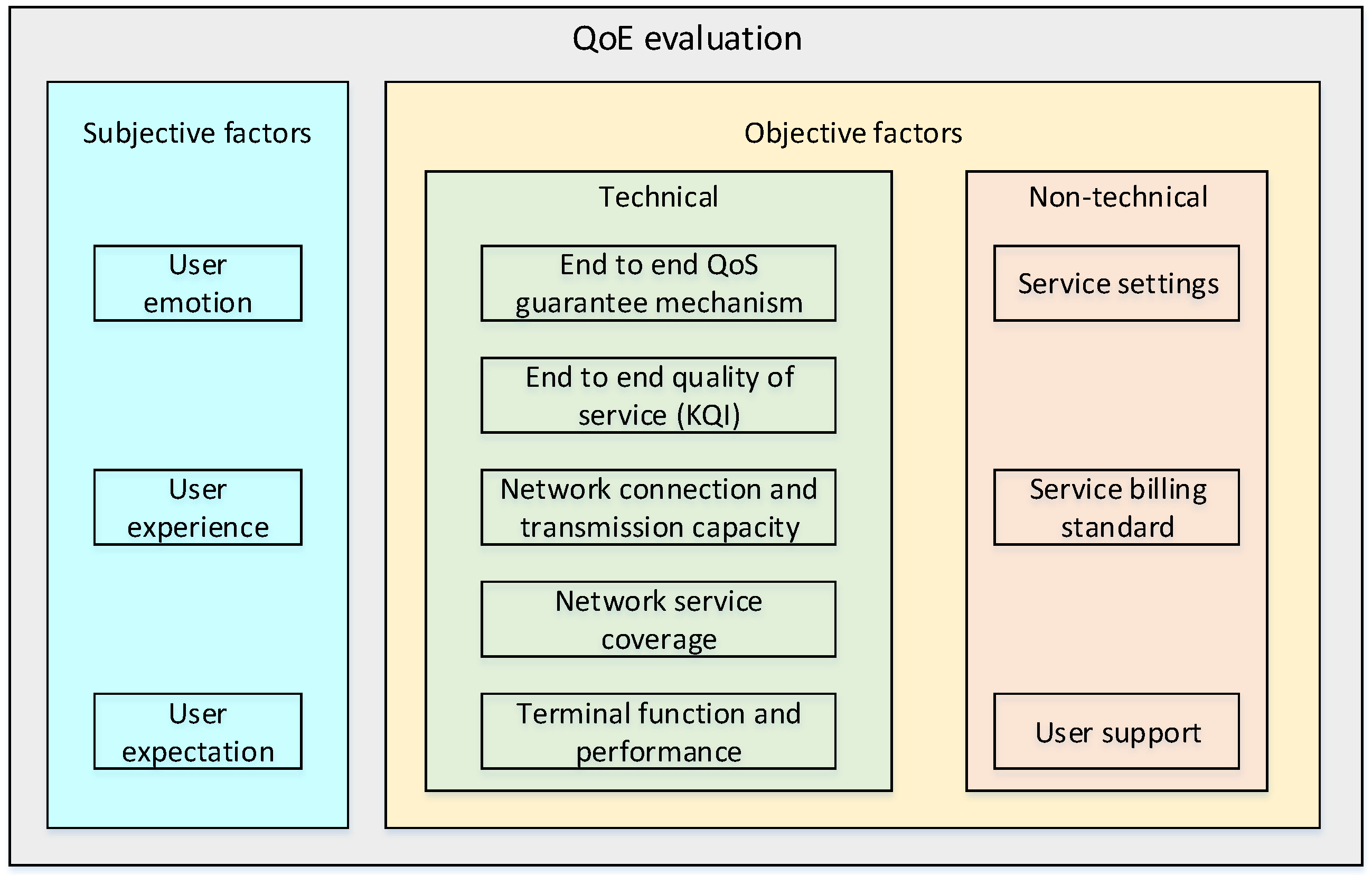
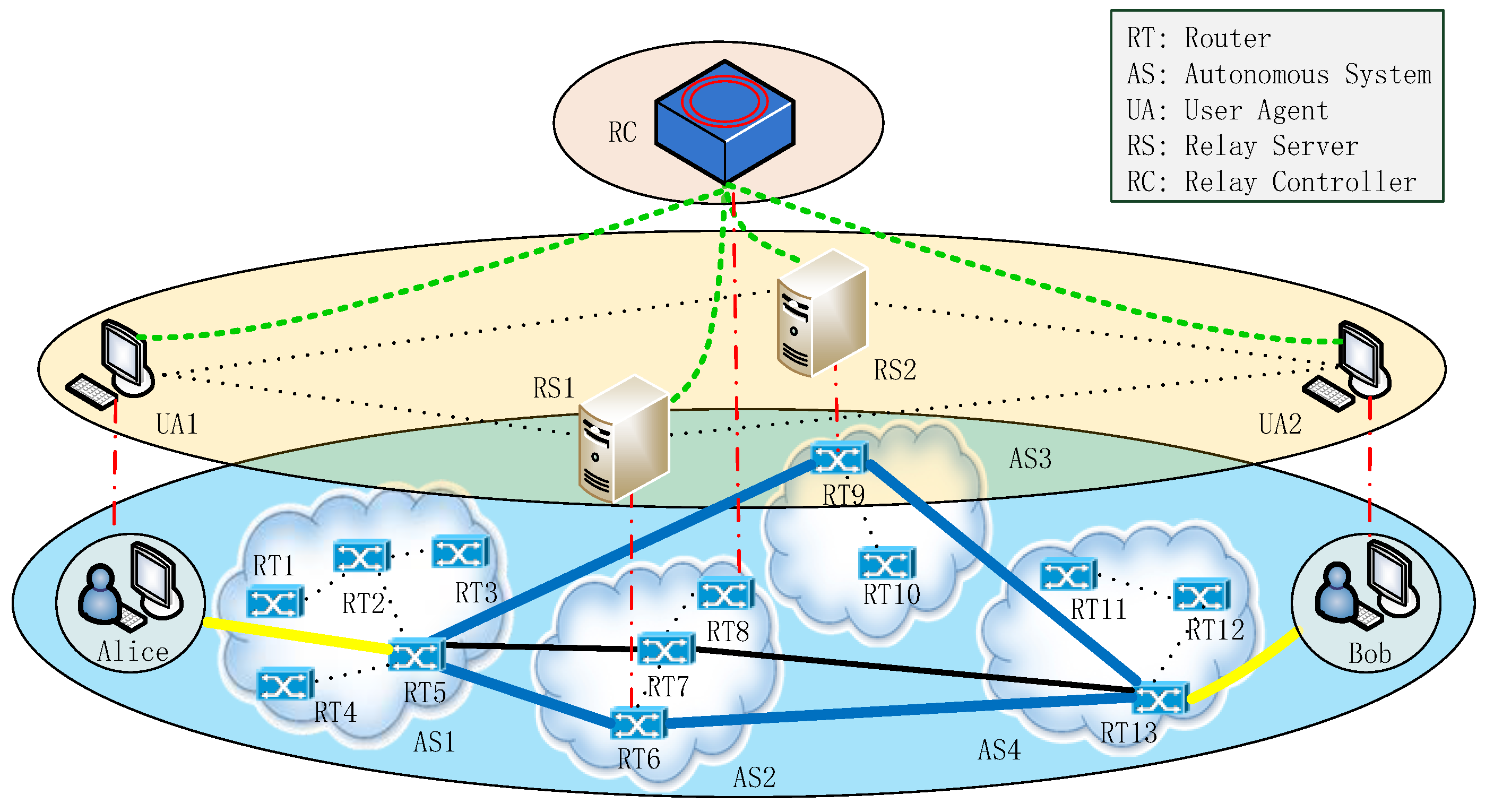
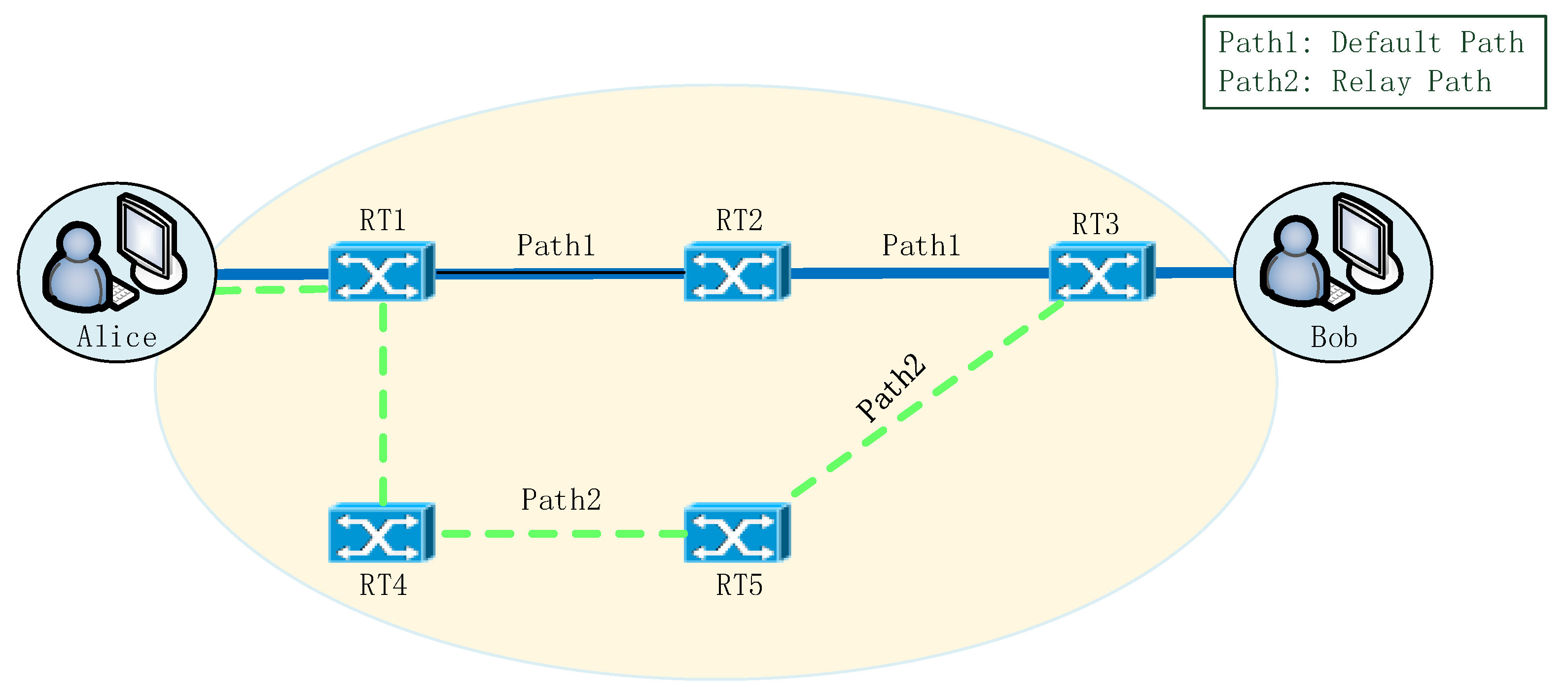
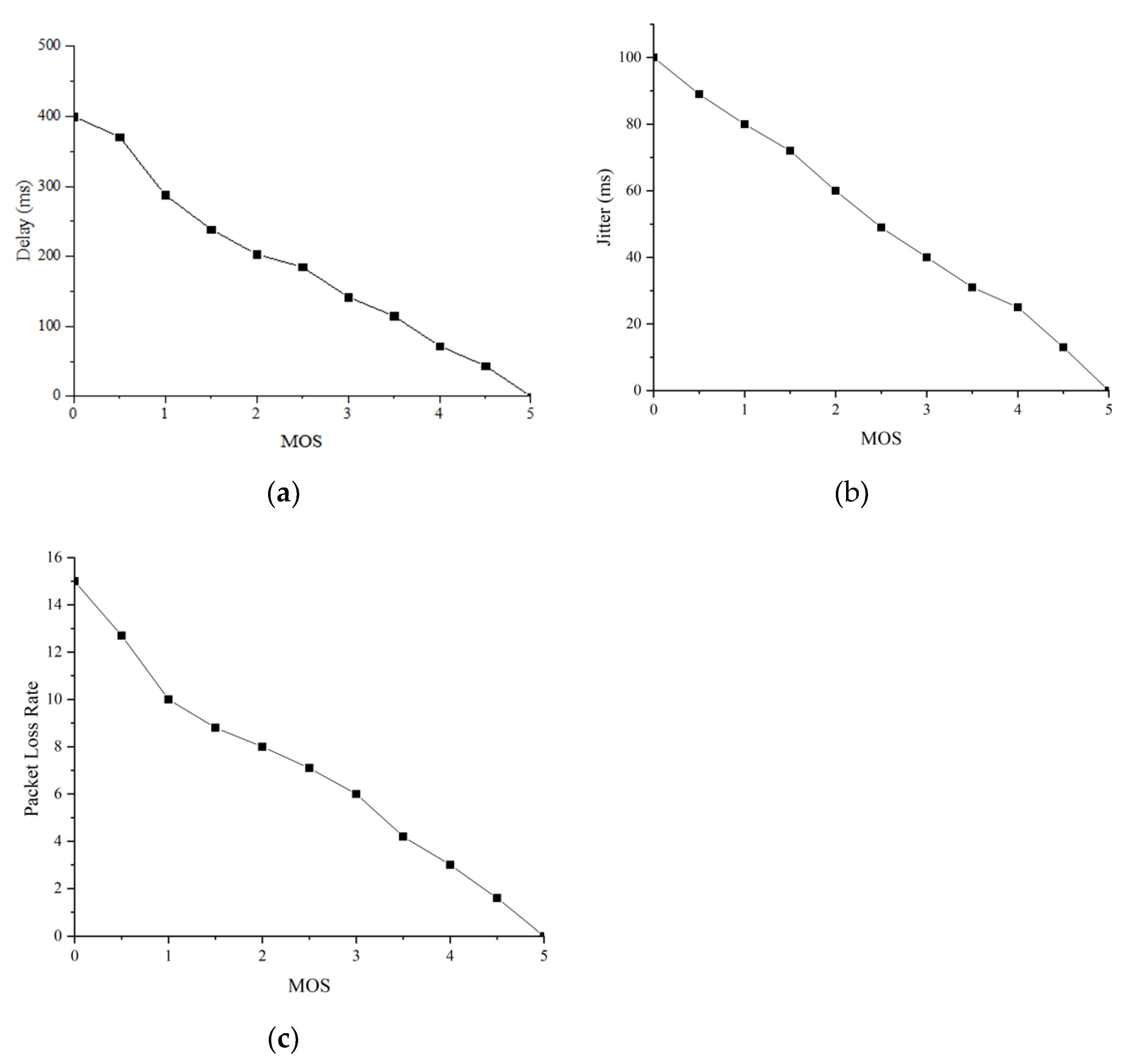
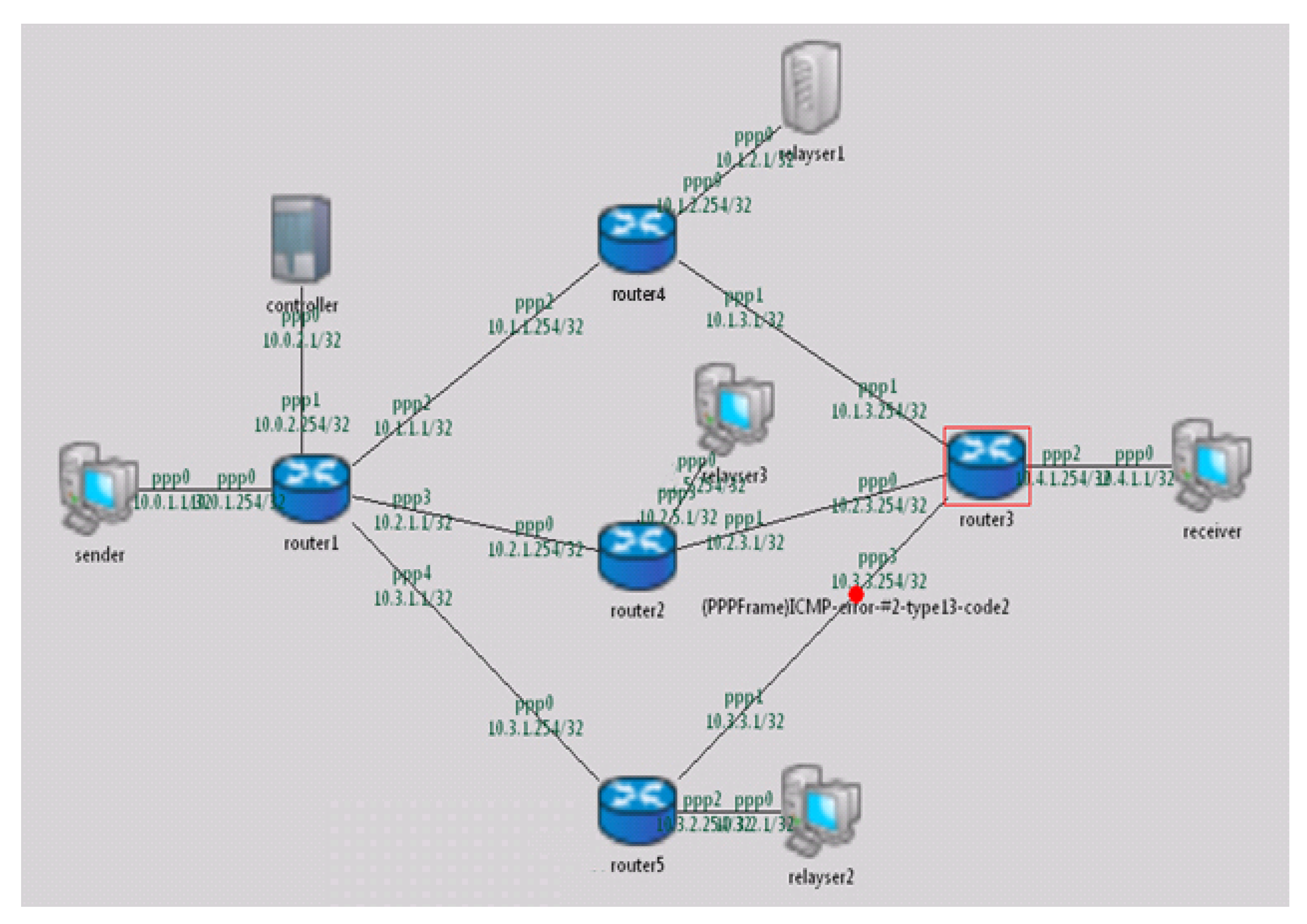
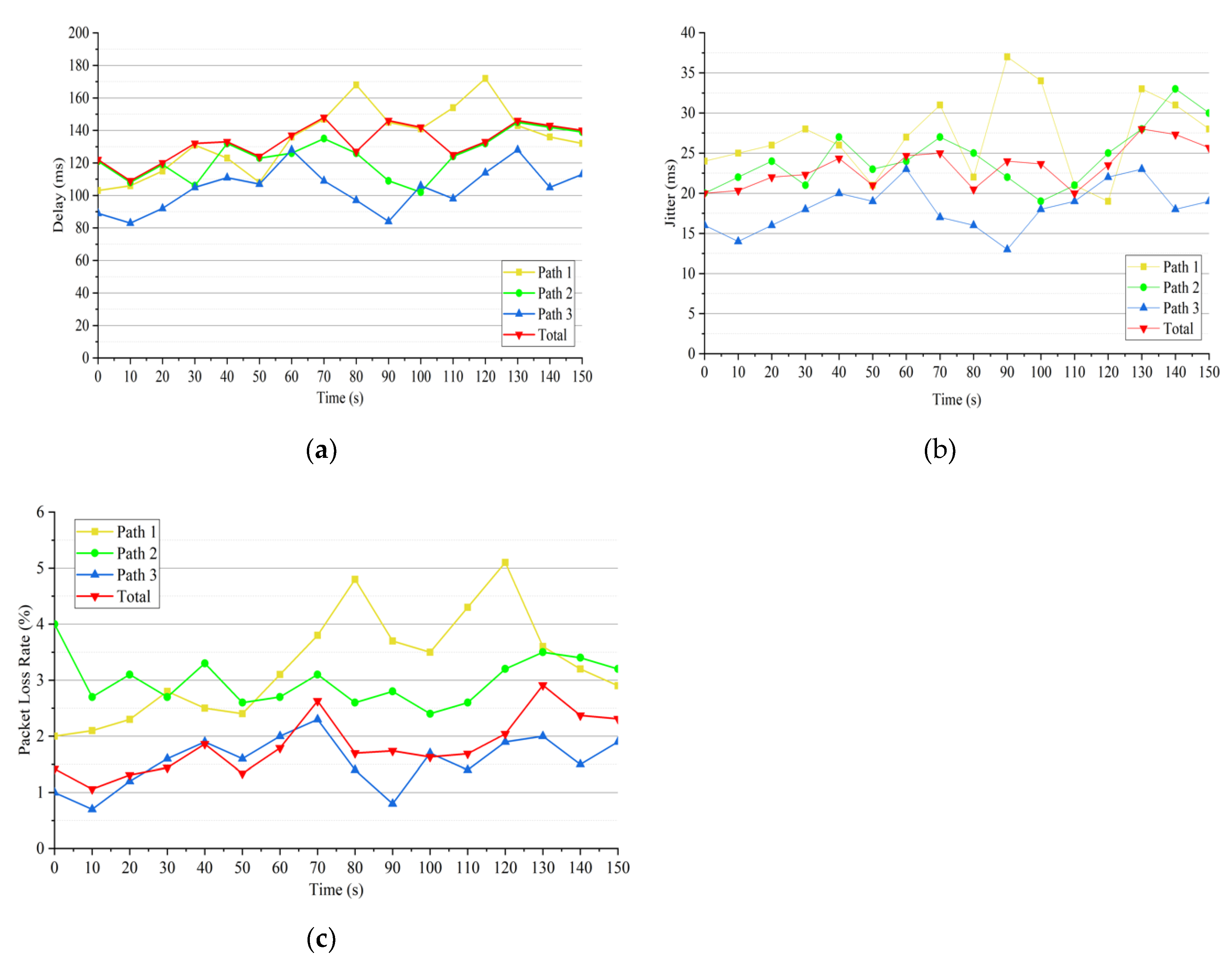
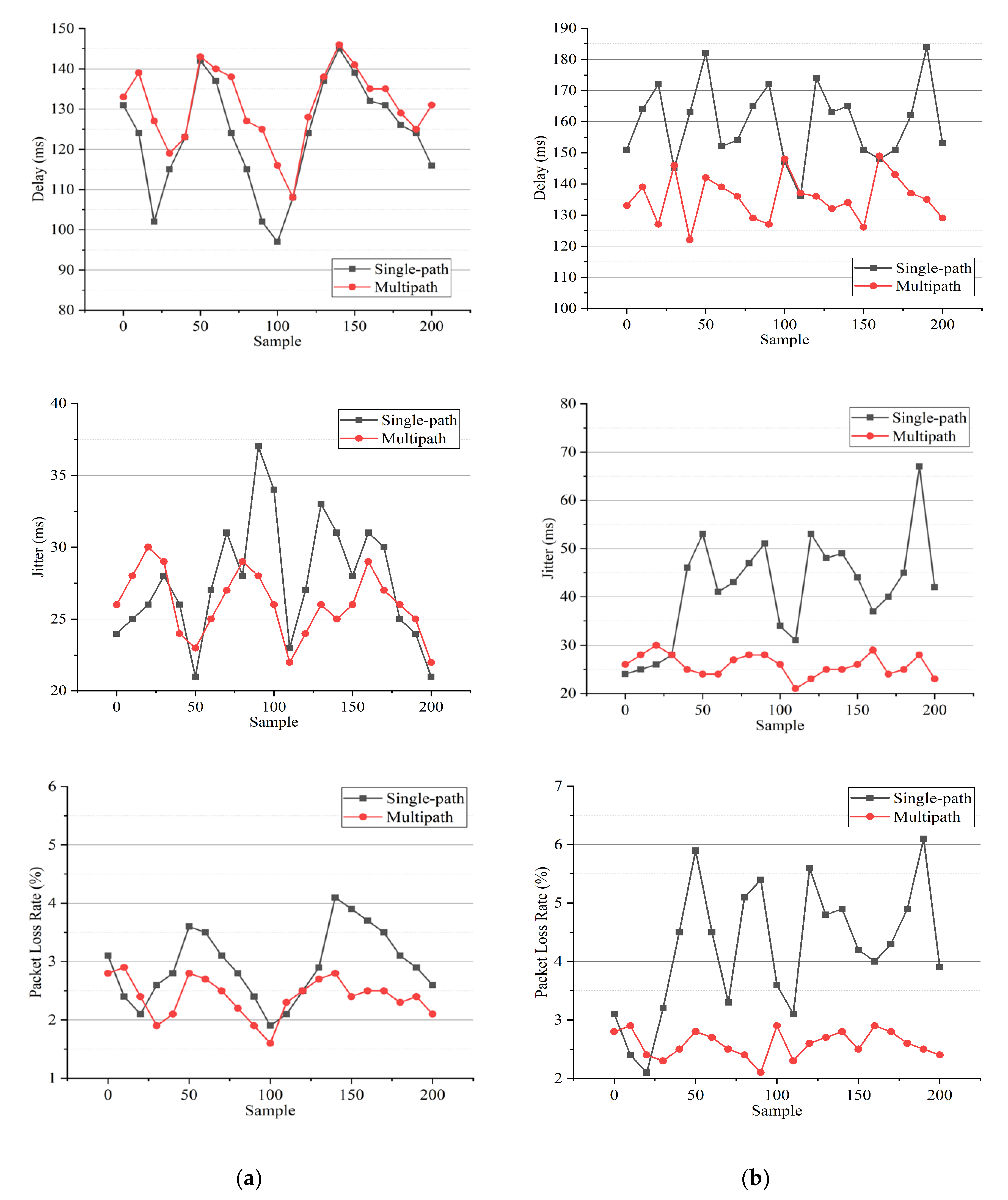
| Conversational Service | QoE Characteristics |
|---|---|
| The service transmission characteristics | Small end-to-end delay Upstream and downstream traffic are symmetrical or almost symmetrical |
| The main QoS (Quality of Service) indicators of service | Delay (strictly limited) Jitter (strictly limited) Packet loss (restriction) |
| The service priority | Highest priority Guaranteed delay Reserved bandwidth |
| MOS Grade | QoE Evaluation | Degree of Damage |
|---|---|---|
| 5 | Excellent | No perceiving |
| 4 | Good | Can be perceived but not serious |
| 3 | Common | Slight |
| 2 | Bad | Serious |
| 1 | Very bad | Very serious |
| Path | Delay | Jitter | Packet Loss Rate | Bandwidth |
|---|---|---|---|---|
| path1 | 103 ms | 24 ms | 2% | 10 Mbit/s |
| path2 | 121 ms | 20 ms | 4% | 13 Mbit/s |
| path3 | 89 ms | 16 ms | 1% | 12 Mbit/s |
© 2020 by the authors. Licensee MDPI, Basel, Switzerland. This article is an open access article distributed under the terms and conditions of the Creative Commons Attribution (CC BY) license (http://creativecommons.org/licenses/by/4.0/).
Share and Cite
Zhan, Y.; Lei, W.; Guan, Y.; Li, H. Research on the Load Distribution Strategy to Meet the QoE Requirements for Conversational Real-Time HD Video Service. Electronics 2020, 9, 790. https://doi.org/10.3390/electronics9050790
Zhan Y, Lei W, Guan Y, Li H. Research on the Load Distribution Strategy to Meet the QoE Requirements for Conversational Real-Time HD Video Service. Electronics. 2020; 9(5):790. https://doi.org/10.3390/electronics9050790
Chicago/Turabian StyleZhan, Yuzhuo, Weimin Lei, Yunchong Guan, and Hao Li. 2020. "Research on the Load Distribution Strategy to Meet the QoE Requirements for Conversational Real-Time HD Video Service" Electronics 9, no. 5: 790. https://doi.org/10.3390/electronics9050790
APA StyleZhan, Y., Lei, W., Guan, Y., & Li, H. (2020). Research on the Load Distribution Strategy to Meet the QoE Requirements for Conversational Real-Time HD Video Service. Electronics, 9(5), 790. https://doi.org/10.3390/electronics9050790





